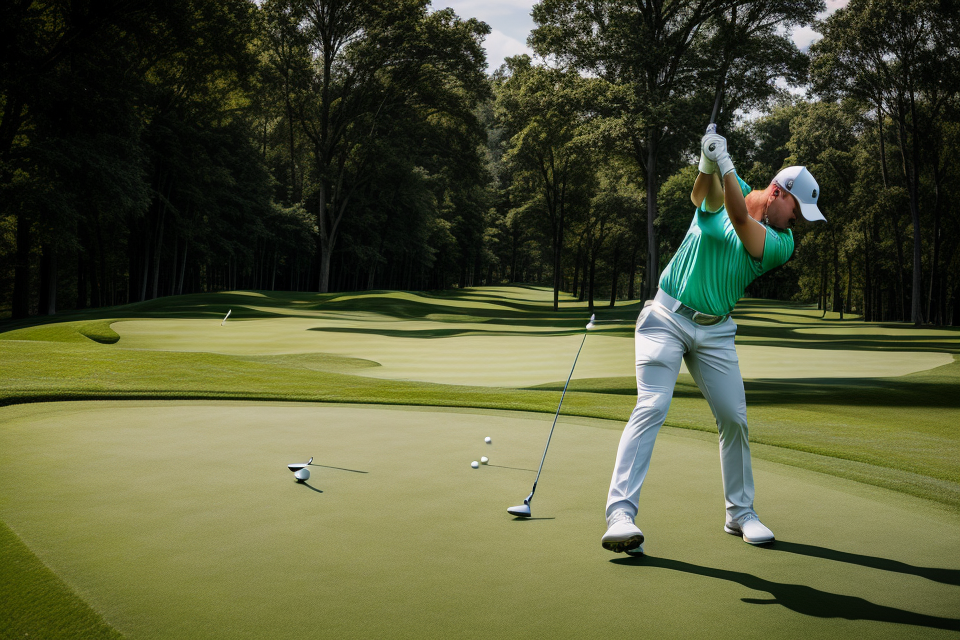
Are you looking to improve your golf game? A well-designed golf exercise plan can help you achieve your goals and take your game to the next level. Golf is a physically demanding sport that requires strength, flexibility, and endurance. By incorporating targeted exercises into your routine, you can increase your power and accuracy, reduce your risk of injury, and enhance your overall performance on the course. In this article, we’ll explore the benefits of a golf exercise plan and provide tips for creating a personalized workout routine that will help you play better golf. So, get ready to step up your game and take your swing to new heights!
A golf exercise plan can improve your game by increasing your strength, flexibility, and overall physical fitness. This can help you swing the club with more power and accuracy, resulting in longer drives and more accurate shots. Additionally, a golf exercise plan can help prevent injuries and improve your endurance on the course, allowing you to play your best game over an entire round. It is important to consult with a professional, such as a golf instructor or a personal trainer, to design a golf exercise plan that is tailored to your specific needs and goals.
Benefits of golf fitness
Improved physical performance
A golf exercise plan can improve your physical performance on the golf course by increasing your strength and endurance, enhancing your mobility and flexibility, and improving your balance and coordination.
Increased strength and endurance
Having strong muscles in your upper and lower body is essential for a successful golf swing. A golf exercise plan can help you build strength in your core, legs, and arms, which can increase your power and endurance on the course. Strength training exercises such as weightlifting, resistance bands, and bodyweight exercises can be incorporated into a golf fitness routine to improve overall physical performance.
Enhanced mobility and flexibility
Mobility and flexibility are crucial for a golf swing that has power and control. A golf exercise plan can help improve your range of motion and flexibility, which can lead to more efficient and effective swings. Stretching, yoga, and Pilates are examples of exercises that can help improve mobility and flexibility.
Better balance and coordination
Balance and coordination are critical for a successful golf swing, as they help you maintain control over your body during the swing and make solid contact with the ball. A golf exercise plan can help improve your balance and coordination by incorporating exercises that challenge your stability and proprioception. Exercises such as single-leg deadlifts, balance boards, and proprioception drills can be included in a golf fitness routine to improve balance and coordination.
In conclusion, a golf exercise plan can improve your physical performance on the golf course by increasing your strength and endurance, enhancing your mobility and flexibility, and improving your balance and coordination. Incorporating strength training, stretching, yoga, Pilates, balance and proprioception exercises into your routine can lead to a more efficient and effective golf swing, resulting in better performance on the course.
Reduced risk of injury
Implementing a golf exercise plan can significantly reduce the risk of injury while playing golf. Golfers who regularly engage in physical conditioning exercises are less likely to experience injuries than those who do not. The following are some of the reasons why a golf exercise plan can help reduce the risk of injury:
Strengthening of muscles and joints
Golf is a sport that requires a lot of physical effort, particularly in the upper body. A golf exercise plan focuses on strengthening the muscles and joints that are used during the swing, which can help prevent injuries. By strengthening the muscles in the shoulders, arms, and back, golfers can improve their swing mechanics and reduce the risk of injury.
Prevention of overuse injuries
Overuse injuries are common in golfers who play frequently or engage in repetitive motions during their swings. These injuries can be caused by muscle imbalances, poor posture, or weak muscles. A golf exercise plan can help prevent overuse injuries by improving muscle balance, strengthening weak muscles, and promoting proper posture.
Improved body mechanics
A golf exercise plan can also help improve body mechanics, which can reduce the risk of injury. Golfers who have good body mechanics are less likely to experience injuries because they use proper swing techniques and avoid awkward movements that can lead to injury. By incorporating exercises that improve flexibility, balance, and stability, golfers can improve their body mechanics and reduce the risk of injury.
Improved mental focus
Reduced stress and anxiety
Physical activity has been shown to have a positive impact on mental health. Exercise releases endorphins, which are natural mood boosters, and can help reduce stress and anxiety levels. By incorporating golf-specific exercises into your fitness routine, you can experience a decrease in stress and anxiety, leading to a more relaxed and focused state of mind on the golf course.
Enhanced concentration and attention
Golf requires a high level of concentration and attention to detail. By improving your physical fitness through targeted exercises, you can enhance your mental focus and concentration. Strengthening your core, improving your balance and flexibility, and increasing your overall physical stamina can all contribute to better concentration on the golf course.
Better overall well-being
A comprehensive golf exercise plan that includes cardiovascular exercises, strength training, and flexibility work can lead to improved overall well-being. By taking care of your physical health, you can improve your mental well-being, reducing the risk of fatigue and burnout. This, in turn, can lead to a more positive and focused mindset on the golf course, allowing you to perform at your best.
Developing a golf exercise plan
Assessing your fitness level
Assessing your fitness level is a crucial step in developing a golf exercise plan that is tailored to your needs. It will help you identify areas of strength and weakness, which will allow you to set realistic goals and create a customized workout plan that will help you improve your game. Here are some ways to assess your fitness level:
- Cardiovascular fitness: Golf requires a certain level of cardiovascular fitness, as it involves walking and carrying your own bag, which can add up to several miles over the course of a round. To assess your cardiovascular fitness, you can perform a maximum heart rate test, such as a VO2 max test, or a sub-maximal test, such as a graded exercise test.
- Muscular strength and endurance: Golf also requires muscular strength and endurance in the upper body, particularly in the core, shoulders, and arms. To assess your muscular strength and endurance, you can perform exercises such as push-ups, pull-ups, and bench presses, and measure your one-repetition maximum (1RM) for each exercise.
- Flexibility and mobility: Golf also requires good flexibility and mobility, particularly in the hips, legs, and shoulders. To assess your flexibility and mobility, you can perform tests such as the sit-and-reach test, the hamstring stretch test, and the shoulder flexibility test.
- Body composition: Your body composition can also affect your golf performance, as it determines how much muscle mass and body fat you have. To assess your body composition, you can measure your weight, height, and waist circumference, and calculate your body mass index (BMI). You can also use bioelectrical impedance analysis (BIA) to estimate your body composition.
By assessing your fitness level, you can identify areas where you need to improve and tailor your golf exercise plan to your specific needs. This will help you develop the strength, endurance, flexibility, and body composition necessary to improve your golf performance and reduce your risk of injury.
Incorporating various exercises
Incorporating various exercises is a crucial aspect of developing a golf exercise plan. A well-rounded exercise plan should include a combination of cardiovascular exercises, strength training exercises, flexibility and mobility exercises, and balance and coordination exercises. Each of these types of exercises serves a specific purpose in improving your golf game.
Cardiovascular exercises
Cardiovascular exercises, such as running, cycling, or swimming, are essential for improving your overall fitness level and endurance. These exercises help increase your heart rate and circulation, which can improve your stamina and reduce fatigue during a round of golf.
Strength training exercises
Strength training exercises, such as weightlifting or resistance band exercises, are important for building muscular strength and endurance. These exercises can help improve your swing speed and power, as well as reduce your risk of injury.
Flexibility and mobility exercises
Flexibility and mobility exercises, such as stretching or yoga, are essential for maintaining and improving your range of motion and flexibility. These exercises can help prevent injuries and improve your ability to make a smooth, fluid swing.
Balance and coordination exercises
Balance and coordination exercises, such as tai chi or balance training, are important for improving your balance and stability on the golf course. These exercises can help improve your posture and alignment, as well as reduce your risk of slips, trips, and falls on uneven terrain.
By incorporating a variety of exercises into your golf exercise plan, you can improve your overall physical fitness, increase your stamina and endurance, and reduce your risk of injury.
Integrating golf-specific drills
Incorporating golf-specific drills into your exercise plan is essential for improving your game. These drills target the muscles used during golf swings and other movements on the course, helping to enhance your overall performance. Here are some examples of golf-specific drills that you can include in your exercise plan:
- Swing mechanics drills: These drills focus on improving the mechanics of your golf swing, including your backswing, downswing, and follow-through. Examples of swing mechanics drills include using a resistance band to increase clubhead speed, practicing your swing with a weighted club, and using a mirror to check your swing form.
- Putting drills: Putting is a crucial aspect of golf, and incorporating putting drills into your exercise plan can help improve your accuracy and consistency on the green. Examples of putting drills include practicing your stroke with a ball, using a putting mat to practice different putts, and using a drill that involves rolling the ball along a straight line.
- Chipping and pitching drills: Chipping and pitching are important shots that can make a big difference in your game. Golf-specific drills for chipping and pitching can help improve your accuracy and distance control when hitting these shots. Examples of chipping and pitching drills include practicing your chip shots with a ball, using a mat to practice different chips, and using a drill that involves hitting balls from different lies.
- On-course golf fitness drills: In addition to practicing on the driving range, it’s important to incorporate on-course fitness drills into your exercise plan. These drills help simulate the physical demands of playing a round of golf, including walking, carrying your bag, and hitting shots from various lies. Examples of on-course fitness drills include walking a course with a weighted bag, practicing hitting shots from rough and hazard areas, and practicing uphill and downhill shots.
Incorporating recovery and nutrition
Proper recovery and nutrition are essential components of a golf exercise plan. They help to optimize performance, reduce the risk of injury, and speed up the recovery process. Here are some ways to incorporate recovery and nutrition into your golf exercise plan:
Proper warm-up and cool-down techniques
A proper warm-up before golfing is essential to prepare your muscles for the physical demands of the game. A good warm-up should include dynamic stretching exercises that target the muscles used in golf, such as the legs, hips, and upper body. This helps to increase blood flow to the muscles, reduce the risk of injury, and improve flexibility.
After golfing, it’s important to cool down to prevent muscle soreness and improve recovery. A cool-down should include static stretching exercises that target the same muscles used during the warm-up. This helps to lengthen the muscles and improve flexibility.
Stretching and foam rolling
Static stretching exercises should be incorporated into your golf exercise plan to improve flexibility and reduce the risk of injury. Stretching helps to elongate the muscles and increase range of motion, which can improve swing mechanics and reduce the risk of injury.
Foam rolling is another effective technique for improving flexibility and reducing muscle soreness. Foam rolling involves using a foam roller to apply pressure to tight or sore muscles, which can help to release tension and improve blood flow to the muscles.
Hydration and nutrition for optimal performance
Proper hydration and nutrition are essential for optimal performance on the golf course. Dehydration can lead to fatigue, dizziness, and headaches, which can all negatively impact your game. It’s important to drink plenty of water before, during, and after golfing to stay hydrated.
In addition to hydration, proper nutrition is essential for maintaining energy levels and providing the necessary nutrients for muscle recovery. Golfers should focus on consuming a balanced diet that includes plenty of fruits, vegetables, whole grains, and lean protein.
Overall, incorporating recovery and nutrition into your golf exercise plan can help to improve your performance on the golf course, reduce the risk of injury, and speed up the recovery process.
Tracking progress and making adjustments
Monitoring progress
Tracking progress is an essential aspect of any exercise plan, and golf is no exception. By monitoring your progress, you can assess the effectiveness of your training program and make necessary adjustments to optimize your performance on the golf course. Here are some ways to monitor your progress:
- Keeping a fitness journal: A fitness journal is a great way to track your progress over time. It allows you to record your workouts, including the exercises you performed, the number of sets and reps, and the weight used. You can also note any changes in your physical performance, such as increased strength or endurance. By reviewing your fitness journal regularly, you can identify patterns and trends in your progress and make adjustments to your training program as needed.
- Tracking improvements in physical performance: In addition to keeping a fitness journal, it’s important to track improvements in your physical performance. This can include measuring your strength, endurance, flexibility, and balance. For example, you can measure your grip strength using a hand grip dynamometer, or you can measure your cardiovascular endurance by completing a timed mile run. By tracking these measurements over time, you can see how your body is changing and adjust your training program accordingly.
- Assessing mental focus and well-being: While physical fitness is important for golf performance, mental focus and well-being are equally critical. To assess your mental focus, you can track your scores on the golf course and look for patterns in your performance. For example, if you tend to struggle with your driver, you may want to focus on improving your mental visualization skills. To assess your well-being, you can track your sleep patterns, stress levels, and overall mood. By monitoring these factors, you can identify areas where you need to improve your mental game and make adjustments to your training program accordingly.
Overall, monitoring your progress is an essential part of any golf exercise plan. By tracking your physical performance, mental focus, and well-being, you can identify areas for improvement and make adjustments to optimize your performance on the golf course.
Making adjustments
Making adjustments to your golf exercise plan is an essential aspect of improving your game. This section will discuss how to periodically reassess your fitness level, adjust your workout plan as needed, and incorporate new exercises and drills to prevent plateauing.
Periodically reassessing fitness level
Periodically reassessing your fitness level is crucial to ensure that you are making progress and to identify areas that need improvement. You can do this by using performance metrics such as driving distance, accuracy, and swing speed. Additionally, you can use body composition measurements, such as body fat percentage and muscle mass, to assess your overall fitness level.
Adjusting workout plan as needed
As you progress through your golf exercise plan, it’s essential to adjust your workout plan as needed to continue making improvements. This may involve increasing the intensity or duration of your workouts or incorporating new exercises to target specific areas of your game. For example, if you’re struggling with your driving distance, you may want to incorporate exercises that focus on increasing your power and strength.
Incorporating new exercises and drills to prevent plateauing
Incorporating new exercises and drills is essential to prevent plateauing and continue making progress. This may involve trying new exercises or incorporating drills that target specific areas of your game. For example, if you’re struggling with your accuracy, you may want to incorporate drills that focus on improving your aim and precision.
In conclusion, making adjustments to your golf exercise plan is essential to ensure that you continue making progress and improving your game. By periodically reassessing your fitness level, adjusting your workout plan as needed, and incorporating new exercises and drills, you can continue to make improvements and reach your golfing goals.
Recap of benefits of golf fitness
- Improved physical performance: Golf fitness exercises help improve physical performance by targeting the muscles used in the golf swing, such as the core, legs, and upper body. This results in increased power, distance, and accuracy, which can all contribute to a better overall game.
- Reduced risk of injury: Golfers who participate in regular fitness exercises are less likely to experience injuries, such as lower back pain or shoulder injuries, that can impact their ability to play. Golf-specific exercises also help improve flexibility and balance, which can reduce the risk of falls and other accidents on the course.
- Improved mental focus: Golf requires a high level of mental focus and concentration, and golf fitness exercises can help improve these skills. Regular physical activity has been shown to increase cognitive function and reduce stress levels, which can help golfers stay focused and calm under pressure. Additionally, golf fitness exercises can help improve overall mood and energy levels, which can positively impact performance on the course.
Importance of developing a golf exercise plan
Creating a golf exercise plan is essential for improving your game. This plan should be tailored to your specific needs and goals, taking into account your current fitness level, any physical limitations, and your desired outcomes. Here are some reasons why developing a golf exercise plan is crucial:
Customized workout plan
A customized workout plan takes into account your unique needs and goals. This plan should include exercises that target the muscles used in golf, such as the core, legs, and upper body. By incorporating exercises that specifically target these areas, you can improve your overall strength, flexibility, and balance, which can all contribute to better performance on the golf course.
Integration of various exercises and drills
A golf exercise plan should also include a variety of exercises and drills to keep things interesting and to challenge your body in different ways. For example, you might include exercises that focus on improving your swing mechanics, as well as drills that help you develop better balance and coordination. By incorporating a range of exercises and drills, you can work on different aspects of your game and make improvements in multiple areas.
Incorporation of recovery and nutrition
In addition to a customized workout plan and a variety of exercises and drills, a golf exercise plan should also include a focus on recovery and nutrition. This might include stretching and foam rolling exercises to help you recover from your workouts, as well as recommendations for healthy eating habits that can support your training. By paying attention to both your exercise and nutrition, you can ensure that you are optimizing your performance on the golf course.
Encouragement to start a golf exercise plan
Starting a golf exercise plan can be an excellent way to improve your game, but it may also require some encouragement. Here are some reasons why you should consider starting a golf exercise plan:
- Improved performance on the golf course
- Enjoyment of the game
- Overall well-being and quality of life
By starting a golf exercise plan, you can expect to see improvements in your performance on the golf course. Golf is a sport that requires a lot of physical fitness, including strength, flexibility, and endurance. A golf exercise plan can help you develop these physical attributes, which can translate into better shots and lower scores.
Additionally, starting a golf exercise plan can also make the game more enjoyable. Golf can be a frustrating sport, especially when you’re not playing well. However, by improving your physical fitness, you can reduce the physical strain of the game, which can make it more enjoyable overall.
Finally, a golf exercise plan can also have a positive impact on your overall well-being and quality of life. Golf is a sport that can be played for a lifetime, and by starting a golf exercise plan, you can improve your physical fitness and reduce the risk of injury, which can allow you to enjoy the game for many years to come.
FAQs
1. What is a golf exercise plan?
A golf exercise plan is a program designed to improve physical fitness and golf performance. It typically includes exercises that target the muscles used in golf swings, such as the core, legs, and upper body. The plan may also include flexibility and mobility exercises to prevent injury and improve range of motion.
2. How does a golf exercise plan improve my game?
A golf exercise plan can improve your game by increasing your strength, power, and endurance. Stronger muscles can help you generate more speed and distance on your swings, while improved flexibility and mobility can help you make a smoother, more powerful swing. Additionally, a golf exercise plan can help prevent injuries and improve your overall physical fitness, which can help you play better over the long term.
3. What are some exercises I can do as part of a golf exercise plan?
There are many exercises that can be included in a golf exercise plan, depending on your specific needs and goals. Some common exercises include plank variations, deadlifts, lunges, and shoulder presses. It’s important to work with a qualified personal trainer or fitness professional to design a program that’s tailored to your individual needs and goals.
4. How often should I do a golf exercise plan?
The frequency of your golf exercise plan will depend on your goals and the intensity of your workouts. As a general guideline, it’s recommended to do strength training exercises at least two to three times per week, with at least one day of rest in between. Flexibility and mobility exercises can be done daily, and should be incorporated into your warm-up and cool-down routines.
5. Can a golf exercise plan help me lose weight?
While a golf exercise plan is primarily designed to improve your golf performance, it can also help you lose weight and improve your overall physical fitness. However, it’s important to remember that weight loss is primarily achieved through a calorie deficit, so you’ll still need to pay attention to your diet and overall calorie intake. That being said, a golf exercise plan can help you build muscle and burn calories, which can help you reach your weight loss goals.


